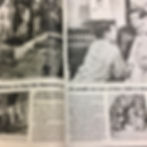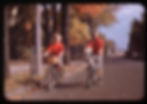Taking a LOOK at the Hometown USA Color Slide Collection
- Tisha Dolton
- Aug 21, 2020
- 4 min read
Updated: Dec 5, 2020
Back in the beginning of 2020, I was approached to revisit our slide show presentation of Hometown, USA as a complimentary program to the Chapman Museum's exhibition: LET’S ALL FIGHT, The Linc Cathers Collection of WWII Home Front Posters. Well, COVID-19 forced many changes upon us. The Chapman did mount their exhibit, but few could visit, so it is currently showing online where you can view it now over your morning coffee while still in your pajamas. My slide show was rescheduled from May to August....

Luckily for me, Don Metivier, Bruce Cole, and Erica Gonyea had already created various "scripts" for the slide show. All I needed to do was rework it a bit to make it my own. Oh, & ask Kevin Rogan to digitize the slides for a PowerPoint/Zoom presentation! Thus armed with scripts from my predecessors, newly digitized slides, copies of the original articles, a couple of chapters from Don Metivier's books, and our collection description I set to work.
I reordered certain sections, and removed some redundant slides. In the presentation itself, I quoted from the original articles, read a couple passages from Don Metivier's books, and excerpted from our collection description.
A collection description is an overview of a collection in an archive that explains to a potential researcher what is in the collection & whether it may contain information relating to the research topic. It is not a detailed inventory of every single document within that collection. A list of search terms associated with the collection is included to aid patrons. The abstract from the collection description is below.
The Look Magazine Glens Falls “Hometown U.S.A.” Photograph Collection contains over 5,000 photographs, mostly black and white prints, but including 359 color slides. These photographs provide a detailed portrait of the Glens Falls area in 1943-1944 during World War II, showing people, streets, buildings, schools, churches, industries, restaurants, hospital, recreation, parades, servicemen, and various wartime activities.

The seven Hometown, USA articles were written by LOOK Magazine copy editor, George F. Koether (1907-2006) and appeared on April 4, April 18, June 27, July 25, September 5, September 19, and November 28, 1944. The over 5,000 photographs were taken by photojournalists Harold Rhodenbaugh (1901-1951), and Betty Truxell, who also taught art & photojournalism at Ohio University.

According to Metivier On Saratoga Glens Falls, Lake George, & the Adirondacks, the color slides are possibly linked to WHY Glens Falls was selected at Hometown, USA in the first place. Don Metivier writes in "Wings/Glens/Glenn's/Hometown Falls"...
...an old employee of Curtis [Publishing Company], long retired, remembered... [d]uring World War II, there was no color film available to the public, it all went to the Signal Corps for military photos. Curtis wanted to shoot the Hometown U.S.A. project in four color as well as black and white, and went to the War Department seeking help... it was made known... that there might be a supply of color slide film available for such a fine, patriotic project if the [Under] Secretary's hometown was given a bit of consideration... Robert Patterson had grown up in a little place called Glens Falls. Glens Falls, New York, a perfect Hometown, U.S.A.
One of the great things about doing a program like this is the questions, comments, and anecdotes from the audience. In the slide below, the blue stars on the banner represent soldiers Albert, Alfred, and Benito Marcantonio. When I did not know what the red star stood for, Linda Marcantonio Maxwell, typed into the chat section on Zoom...
[T]he red star was to represent the service member Mario Garzia who Mr. Marcantonio [brought] from Italy to avoid being put into Mussolini’s army. He became a barber along with all of Mr. Marcantonio’s 3 sons after the war.
Above, you can see some of the propaganda posters put out by the US to promote salvage, and food production during World War II in the Chapman Museum's exhibition.
Another question from the audience was about the paper drive. Salvage for Victory was launched in the US in 1942 to promote recycling paper, scrap metal, old rags, and rubber. It was fashioned after a campaign in the UK that ran from 1939-1950. The September 5, 1944 article Hometown, U.S.A., Helps Win the War With Paper emphasizes that this paper-making city is doing more than its part to recycle paper. Glens Falls Insurance Company alone collected 1 1/2 tons of paper.
This salvaged paper, converted into carton form, will carry food and weapons overseas. Glens Falls, N. Y., shows one way in which the nation's Hometowns can help to relieve our number one shortage.
To view more color images of Hometown, USA, visit our NY Heritage Digital Collections page.
If you missed the slide show, the Chapman Museum recorded my presentation for you to view via YouTube below.
I neglected to share my slide show sources on screen during the presentation. Here they are...
Look Magazine Glens Falls “Hometown U.S.A.” Photograph Collection, The Folklife Center at Crandall Public Library, Glens Falls, NY.
Fun In Hometown, U.S.A. (1944, September 19). Look Magazine, 26-29.
The Green Book. (n.d.). Retrieved August 17, 2020, from https://digitalcollections.nypl.org/collections/the-green-book
A Hometown Fights the War. (1944, April 18). Look Magazine, 51-55.
Hometown, U.S.A. (1944, April 4). Look Magazine, 21-35.
Hometown, U.S.A., Helps Win the War With Paper. (1944, September 5). Look Magazine, 26-29.
Metivier, D. A. (1993). Wings/Glens/Glenn's/Hometown Falls. In Metivier on: Saratoga, Glens Falls, Lake George & the Adirondacks (pp. 149-152). Champaign, IL, IL: Sagamore Pub.
Metivier, D. A. (1987). How 'Hometown' Happened. In Saturday Morning (pp. 175-178). Glens Falls, NY: Post Star.
Where Do We Go From War? (1944, June 27). Look Magazine, 40-44.
Youth Demands Its Own New Deal. (1944, November 28). Look Magazine, 23-27.
Tisha Dolton is Librarian/Historian at The Folklife Center at Crandall Public Library in Glens Falls, NY. Her areas of interest are suffrage music, suffragists of Warren and Washington Counties, local women and minority populations, and embroidery.













